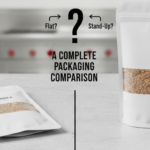
Stand-Up Pouches vs. Rigid Packaging: Which Is Best for Your Food Brand?
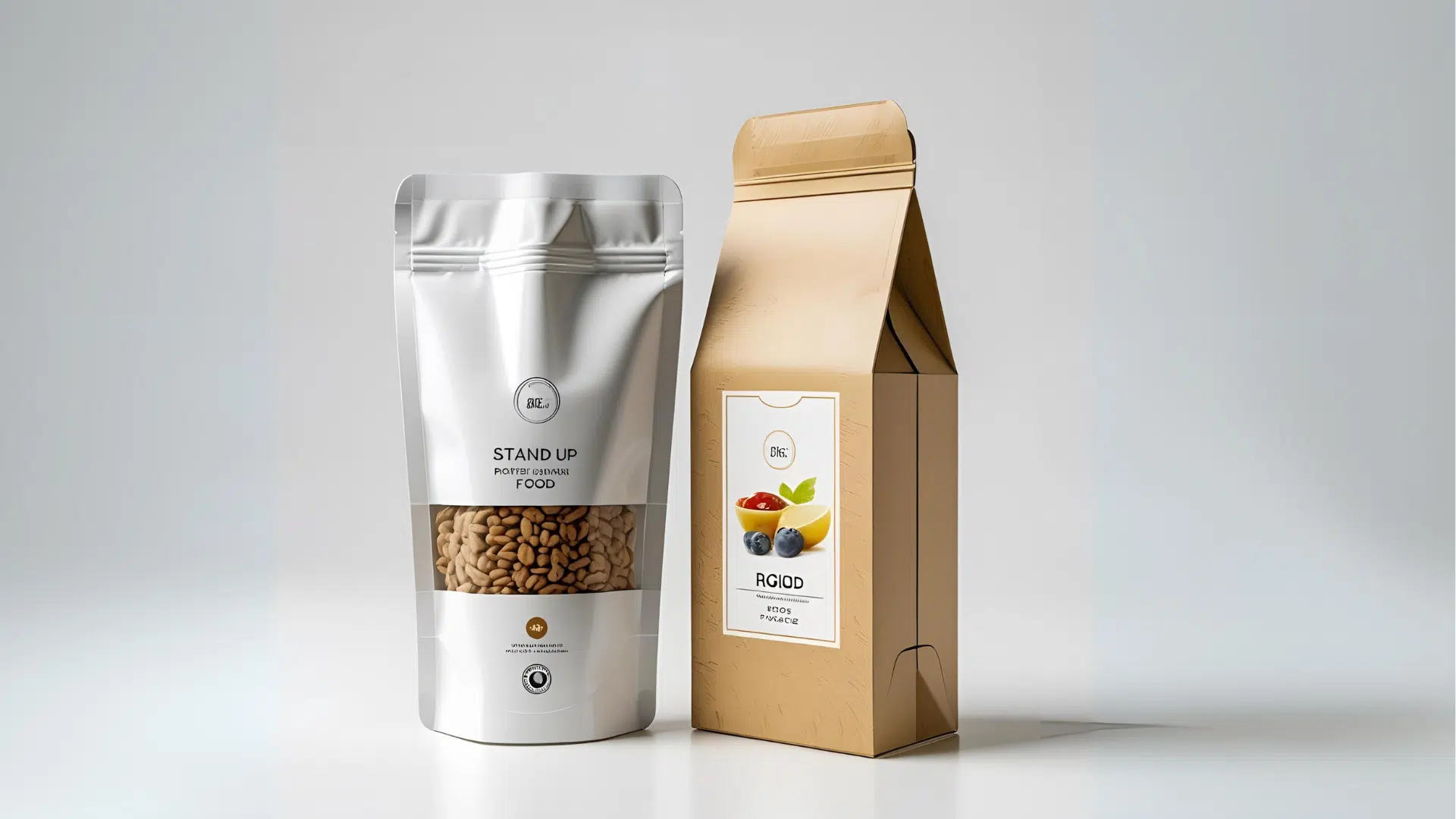
Choosing the right packaging for your food brand is a critical decision that impacts everything from product freshness to customer appeal and operational costs. With so many options available, the debate between stand-up pouches and rigid packaging is one that food businesses frequently encounter.
Both types of packaging have unique strengths and weaknesses, making them suitable for different products and goals. In this blog, we’ll dive into a detailed food packaging comparison, exploring the pros and cons of stand-up pouches vs. rigid packaging to help you decide which is best for your brand.
What Are Stand-Up Pouches?
Stand-up pouches are flexible bags designed to stand upright on their own, thanks to a gusseted bottom. They’re made from lightweight materials like plastic films, foil, or paper laminates and often feature resealable zippers, spouts, or other convenient additions.
These pouches are part of what’s known as flexible packaging, which is highly adaptable and customizable for a wide range of food products, from snacks to sauces.
Stand-up pouches have gained popularity in recent years due to their versatility, cost-effectiveness, and ability to showcase vibrant designs.
They’re commonly used for products like granola, coffee, pet food, and even baby food. But how do they stack up against traditional rigid packaging like cans, jars, or plastic containers?
What Is Rigid Packaging?
Rigid packaging refers to containers that hold their shape, such as glass jars, metal cans, or hard plastic tubs. These are the traditional go-to options for food brands, offering durability and a premium feel. Rigid packaging is often associated with products like canned vegetables, glass-bottled sauces, or plastic yogurt containers.
While rigid packaging has been a staple in the food industry for decades, it comes with its own set of challenges, including higher production costs and less flexibility in design. So, let’s break down the key factors to consider in the flexible packaging vs. rigid packaging debate.
Cost Considerations: Saving Money Without Sacrificing Quality
For food businesses, cost is a major factor when choosing packaging. Stand-up pouches are generally more affordable than rigid packaging. They require less material to produce, are lighter to ship, and take up less storage space.
This translates to lower manufacturing and transportation costs, which can be a game-changer for small or growing brands.
For example, a stand-up pouch for coffee beans might cost significantly less per unit than a metal canister or glass jar. Additionally, flexible pouches can be produced in smaller batches, making them ideal for startups or brands testing new products.
On the other hand, rigid packaging tends to have higher upfront costs due to the materials used (like glass or metal) and the complexity of manufacturing. However, rigid containers can sometimes be reused or recycled more easily, which may appeal to eco-conscious brands willing to invest in sustainable options.
Shelf Appeal: Grabbing Customer Attention
In a crowded marketplace, packaging is your brand’s first impression. Stand-up pouches offer a large surface area for vibrant, eye-catching designs.
Their flexibility allows for creative shapes, clear windows, and bold branding that can stand out on retail shelves. For instance, a colorful pouch of dried fruit with a transparent window showcasing the product can draw customers in more effectively than a plain can.
Rigid packaging, however, has a premium, tactile quality that some consumers associate with high-end products. A glass jar of artisanal jam or a sleek metal tin of cookies can convey luxury and trustworthiness. That said, rigid containers often have less space for creative branding, and labeling can be more expensive or restrictive compared to the full-color printing options available with pouches.
Product Protection: Keeping Food Fresh and Safe
The primary role of any food packaging is to protect the product inside. Both stand-up pouches and rigid packaging can offer excellent protection, but their effectiveness depends on the product.
Stand-up pouches are often made with multi-layered materials that provide barriers against moisture, oxygen, and light. This makes them ideal for products like snacks, spices, or frozen foods that need to stay fresh for extended periods. Features like resealable zippers or vacuum seals further enhance their ability to preserve freshness.
Rigid packaging excels in protecting fragile or perishable items. For example, glass jars are impermeable to air and moisture, making them perfect for sauces or pickled goods.
Metal cans are also highly durable and protect against physical damage, which is crucial for products like canned fish or soups. However, rigid packaging can be heavier, increasing the risk of damage during shipping if not packed carefully.
Sustainability: Meeting Eco-Friendly Goals
Sustainability is a growing concern for food brands as consumers demand environmentally friendly packaging. Stand-up pouches have an edge here because they use less material and are lighter, reducing their carbon footprint during production and transportation. Some pouches are made with recyclable or biodegradable materials, though recycling options for flexible packaging can vary by region.
Rigid packaging, like glass or metal, is often more recyclable than flexible pouches, as these materials are widely accepted in recycling programs. However, producing and transporting rigid containers typically requires more energy, which can offset their environmental benefits. For brands prioritizing sustainability, it’s worth researching local recycling infrastructure and consumer preferences to make an informed choice.
Convenience for Consumers
Consumers look for convenience, and packaging plays a big role in their experience. Stand-up pouches shine in this area with features like resealable zippers, pour spouts, and lightweight designs that are easy to carry and store. For example, a pouch of baby food with a spout is much more convenient for parents on the go than a glass jar.
Rigid packaging can also be user-friendly, especially for products like jars that can be reused at home for storage. However, rigid containers are often bulkier and heavier, which can be less practical for consumers. Additionally, opening a metal can or a tightly sealed jar can sometimes require tools or extra effort, which may frustrate customers.
Storage and Transportation: Efficiency Matters
For food businesses, efficient storage and transportation can significantly impact the bottom line. Stand-up pouches are lightweight and flexible, allowing you to pack more units into a single shipment or store them compactly in a warehouse. This efficiency can reduce shipping costs and make inventory management easier.
Rigid packaging, by contrast, is bulkier and heavier, which can increase shipping and storage costs. For example, glass jars are prone to breakage, requiring extra protective packaging during transport. However, rigid containers are often stackable and durable, which can be an advantage for certain products.
Customization and Scalability
When launching new products or rebranding, flexibility in packaging design is key. Stand-up pouches offer unmatched customization options. You can choose from various sizes, shapes, and features like matte finishes, clear windows, or tear notches. This makes them ideal for brands that want to experiment with unique designs or cater to niche markets.
Rigid packaging is less flexible in terms of design but can still be customized with labels, embossing, or unique shapes. However, making changes to rigid packaging often involves higher costs and longer lead times, which may not suit brands that need to adapt quickly.
Which Is Best for Your Food Brand?
The choice between stand-up pouches and rigid packaging depends on your brand’s priorities, product type, and target audience. Here are some key questions to consider:
- What is your budget? If cost savings are a priority, stand-up pouches are likely the better choice due to their lower production and shipping costs.
- What is your brand image? If you’re aiming for a premium, high-end feel, rigid packaging might better align with your brand. For a modern, trendy vibe, pouches are a great fit.
- What are your product’s needs? Consider whether your product requires maximum protection (rigid) or benefits from lightweight, resealable packaging (pouches).
- How important is sustainability? Evaluate your local recycling options and consumer preferences to choose the most eco-friendly option.
- How do you distribute your products? If you rely heavily on e-commerce, the lightweight nature of pouches could save on shipping costs.
Final Thoughts
In the stand-up pouches vs. rigid packaging debate, there’s no one-size-fits-all answer. Stand-up pouches offer cost savings, design flexibility, and consumer convenience, making them ideal for brands looking to stand out with innovative products. Rigid packaging, on the other hand, provides durability, a premium feel, and widespread recyclability, which may appeal to traditional or luxury brands.
By carefully weighing the factors discussed—cost, shelf appeal, product protection, sustainability, convenience, and scalability—you can choose the packaging that best aligns with your brand’s goals and values. Whether you opt for the modern versatility of flexible packaging or the timeless reliability of rigid packaging, the right choice will help your food brand thrive in a competitive market.
FAQs
- What’s the main difference between stand-up pouches and rigid packaging?
Stand-up pouches are flexible and lightweight, while rigid packaging includes hard containers like glass jars or metal cans that hold their shape.
- Which packaging type is more cost-effective?
Stand-up pouches are generally more affordable due to lower material, shipping, and storage costs.
- Which packaging offers better product protection?
Both offer great protection, but rigid packaging is better for fragile or perishable items, while pouches work well for dry goods and resealable needs.
- Is one option more eco-friendly than the other?
Pouches use less material and energy to ship, but rigid packaging (like glass and metal) is often easier to recycle.
- Which packaging is better for branding and design?
Stand-up pouches offer more space and flexibility for colorful, eye-catching designs, while rigid containers have a more premium, sturdy look.
Share:
Get A Quick Quote
Social Media
Most Popular

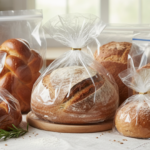
How to Choose the Best Plastic Bread Bags for Freshness and Presentation
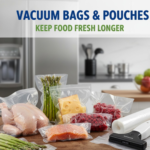
Top Vacuum Bags and Pouches to Keep Food Fresh Longer
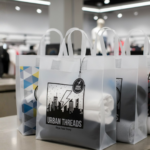
Creative Ways to Use Custom T-Shirt Bags for Brand Promotion
Categories
Tags
Related Posts
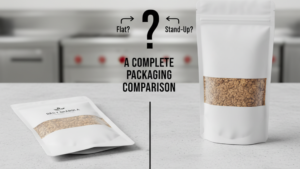
Flat Pouch or Stand-Up Pouch? A Complete Packaging Comparison
In today’s competitive marketplace, choosing the right packaging can make all the difference for your product’s success. Whether you’re launching a new product or refreshing
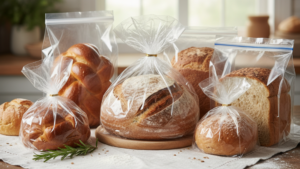
How to Choose the Best Plastic Bread Bags for Freshness and Presentation
In today’s competitive baking industry, quality ingredients and expert recipes are only part of the equation. How your bread is packaged plays a crucial role
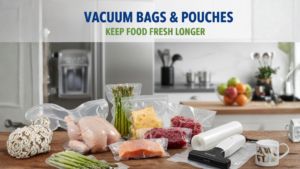
Top Vacuum Bags and Pouches to Keep Food Fresh Longer
Keeping food fresh is still a common concern for any residential or commercial kitchen. One of the easiest and most successful ways to help preserve
